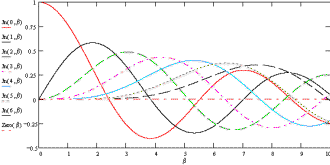|
 Bessel functions
of the first kind are shown in the graph below. In frequency modulation (FM), the carrier
and sideband frequencies disappear when the modulation index (β) is equal to a zero crossing
of the function for the nth sideband. For example, the carrier (0th
sideband) disappears when the Jn(0,β) plot equals zero. It is this feature that broadcasters
exploit to suppress the carrier rather than simply inserting a bandstop filter between the
transmitter and the antenna. Bessel functions
of the first kind are shown in the graph below. In frequency modulation (FM), the carrier
and sideband frequencies disappear when the modulation index (β) is equal to a zero crossing
of the function for the nth sideband. For example, the carrier (0th
sideband) disappears when the Jn(0,β) plot equals zero. It is this feature that broadcasters
exploit to suppress the carrier rather than simply inserting a bandstop filter between the
transmitter and the antenna.
Using a filter greatly reduces the efficiency of the system since the power amplifier is
outputting the carrier signal only to have it shorted to ground via the filter. Adjusting
the modulation index to the proper value causes all of the output power to be concentrated
in the usable signal, thus increasing efficiency. See FM. The 1st sideband disappears when the Jn(1,β) plot equals
zero, the 2nd sideband disappears when the Jn(2,β) equals zero, etc., etc.
Bessel filter pole values can be found here.
Bessel filter prototype values can be
found here.
| J0(β) |
J1(β) |
J2(β) |
J3(β) |
J4(β) |
J5(β) |
J6(β) |
| β = 2.40 β = 5.49 β = 8.65 β = 11.8 |
β = 3.83 β = 7.05 β = 10.2 |
β = 5.14 β = 8.42 β = 11.6 |
β = 6.38 β = 8.42 β = 11.6 |
β = 7.59 β = 11.1 β = 14.4 |
β = 8.77 β = 12.3 β = 15.7 |
β = 9.94 β = 13.6 β = 17.0 |
Note: Graph generated using Mathcad 4.0.
Related Pages on RF Cafe - Amplitude
Modulation - Frequency Modulation -
Quadrature (I/Q) Modulator Sideband Suppression -
Bessel Functions & Graphs -
Modulation Principles, AM Modulation,
NEETS - Modulation Principles,
FM Modulation, NEETS - Modulation
Principles, Demodulation, NEETS - Frequency Mixer, Converter, Multiplier,
Modulator Vendors
|
